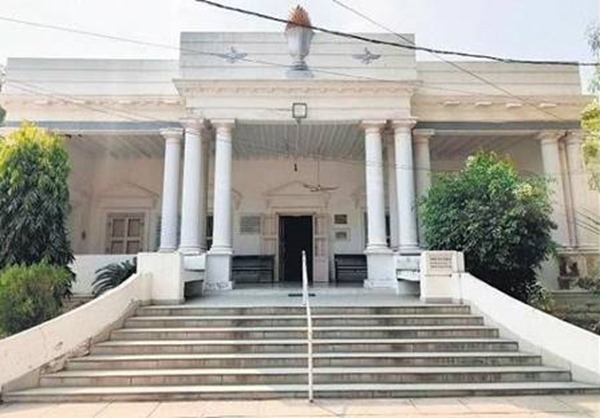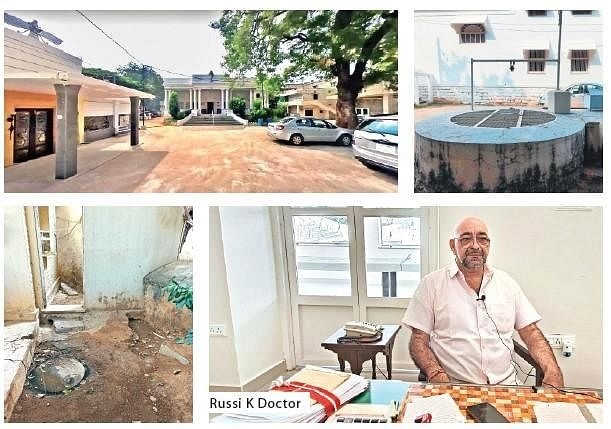The presence of Parsis is etched in local places like Parsigutta and the Chenoy Trade Centre, which bear witness to their historical prominence in the city.
Bai Maneckbai Nusserwanji Chenoy Dar-e-Meher
Article By Shrimansi Kaushik Express News Service
HYDERABAD: Bai Maneckbai Nusserwanji Chenoy Dar-e-Meher at Tilak Road is a pristine monument that recounts the contribution of the Parsi community to Hyderabad. Residents of the Agiary complex are facing serious health hazards due to stagnant sewage water in the compound of the Agiary.
CE explains the historical significance of Agiaries in Hyderabad and the problems residents are facing.
It is easy to miss an almost invisible white gate located on Tilak Road, which grants access to a historically significant building that recounts the narratives of a small community. This is the 119-year-old, Bai Maneckbai Nusserwanji Chenoy Dar-e-Meher, one of the three fire temples in Hyderabad. Consecrated in 1904, this Agiary received the HUDA Heritage Building award in 2001 for its well-maintained structure.
The Zoroastrian community is an integral part of the history of Hyderabad and Secunderabad. Also known as ‘Parsis or Iranis’ since they landed in India from Iran centuries ago, about 1,000 members of the community, comprising 430 families, presently reside in the twin cities. Their history is intricately linked to the cities with many Parsis owning high-ranking positions in Nizam’s administration.
Figures like Nawab Sir Faridoon-ul-Mulk Bahadur and Nawab Sohrab Nawaz Jung Bahadur held pivotal roles. Many were also bestowed with the title of ‘Khan Bahadur’ by the Nizam. The presence of Parsis is etched in local places like Parsigutta and the Chenoy Trade Centre, which bear witness to their historical prominence in the city.
The architecture
‘Agiary’ or ‘Dar-e-Meher’ is a consecrated fire that burns eternally and connects physical and spiritual realms. Seth Viccaji-Seth Pestonji Meherji Fire Temple (176-year-old), Khan Bahadur Edulji Sohrabji Chenoy Anjuman Dar-e-Meher (103-year-old) –– both in Secunderabad and Bai Maneckbai Nusserwanji Chenoy Dar-e-Meher at Tilak Road, Hyderabad are the three historic temples revered as Agiaries in the twin cities.“All religious architecture, even though they followed their own strict principles, in appearance, aligned with the colonial style of architecture that was being pushed on by the British onto the locals.
The style of the doors and the pediments and all the tiny details inside the Agiary are similar to what you find in Chowmahalla Palace or even Falaknuma, suggesting that they were built around the same period and similar styles and construction techniques were used. The traditional go-to solution for ceilings before concrete was bricks laid out on wooden rafters. The roof is something known as the jack arch roof, which is a small series of arches making a massive roof,” said Sibghat Khan from The Deccan Archive, shedding light on the architectural style of the Agiary.
Residents facing problems
Located just off Abid’s road, this Agiary is surrounded by a serene courtyard and residential quarters and houses a sacred well too. In Zoroastrianism, a well is spiritually significant, symbolising the vital link between the material and spiritual realms. It plays a crucial role in sacred rituals, purifying both body and soul. The well’s placement shapes the Agiary’s layout, highlighting its central role. It reflects Zoroastrian beliefs in nature’s sanctity, cleanliness, renewal, and the cyclical nature of life.
Regrettably, the sacredness of the well located in this Agiary complex has been compromised. A private eatery located next to the compound has obstructed the sewage line connected to the residential complex. This blockage has resulted in the drainage flowing back into the compound, where it combines with fresh rainwater in the harvesting pit, ultimately contaminating the sacred well water.
Russi K Doctor
Since March 2022, the 45 families residing in the colony have been facing serious issues due to the accumulation of stagnant sewage water in the compound, particularly worsening on rainy days. Overflowing manholes, ineffective flushing in washrooms, and mosquitoes and worms have compounded the difficulties experienced by the residents. Some of them have even begun to relocate to other areas but most of them are forced to deal with health issues and increased financial burden, as they now have to buy drinking water from outside.
Shaheen Gandavia, a 38-year-old resident of the colony sheds light on the serious health hazard caused by the issue. “The drinking water has been contaminated, causing serious health problems, hospitalising many residents in the colony over two years, including myself. Besides the constant foul odour, there is a risk of getting affected by dangerous methane gas from the manhole that we have to keep open to let the sewage flow out. My neighbours’ twins got infected with dengue which again is a big problem. The conditions here are not livable. This is not a matter of whether we want a comfortable life. We are not even getting the basic necessities to carry on with our day-to-day life.”
Shaheen mentioned that despite frequent complaints to authorities, including the local MLA and the contractor, there’s no relief. “Bureaucratic runarounds leave us frustrated, disrupting our lives,” he said.
“There are two government bodies responsible for this. One is the HMWSSB, which has been cooperating with us from day one. The second is GHMC, which is responsible for regularising the illegal construction done by Santosh Dabha on the sewage line because of which the drain cannot be serviced by the water department. We have brought this to the knowledge of both agencies and contacted the concerned authorities.
GHMC deputy commissioner came to our premises and gave us assurances that they would resolve the issue within 15 days but nothing has been done so far. Now GHMC has said that it doesn’t come under our domain, and we cannot do anything about it. Water Works promised us that they would be removing the sewage through trucks and they are trying to maintain it also. A truck has been coming on a daily basis since then,” said Russi K Doctor, Secretary of the temple trust.
The sewage line was built in line with the 10-feet gradient; the natural slope of the drainage is in the direction of the eatery and blocking it causes the sewage to stagnate in that area. The HMWSSB department has been removing the collected water daily, without which, the place would be uninhabitable, according to the residents. The significant members of the community have also written to Chief Minister K Chandrashekhar Rao and to the union minister Smriti Irani but to no avail.


